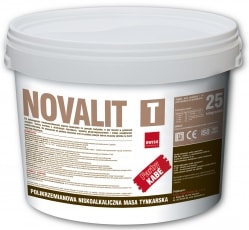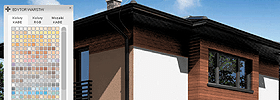NOVALIT T – Polysilicate render

To be used as a manually applied thin top coat for external use and a finish coat for KABE THERM RENO, KABE THERM AVANT * EWI system based on EPS, and KABE THERM MW* EWI system based on mineral wool and NOVALIT RSA anti-cracking system for building renovation. It is used on both mineral substrates (e.g.: concrete, cement render and cement-lime render) and on synthetic substrates covered with well set polymer-based coatings. It is especially recommended in finishing systems for external walls made of materials of porous texture (such as e.g.: lightweight concrete, cinder block, porous brick) and on the walls of new buildings which have not undergone seasoning yet. The substrate should be primed with NOVALIT GT prior to applying the render.
* If a product of EWI system is used, the manufacturer provides a guarantee only when all KABE THERM RENO, KABE THERM AVANT or KABE THERM MW system components are applied.
| Base binder: | specially modified potassium water glass; |
| Pigments: | non-organic coloured pigments resistant to atmospheric conditions; |
| Colours: | natural white, colours from the KABE colour chart and selected NCS colours or samples provided (can be obtained by adding non-organic pigments); |
| Textures: | solid/grained, scraped/mixed, modelled and smooth texture (texture made up of 2 renders: of solid/grained texture with the thickness of 1.5 mm and modelled texture); |
| Grain size: | 1.0 mm; 1.5 mm; 2.0 mm; 2.5 mm; 3.0 mm; |
| Diluent: | water; |
| Temperature of application (air and substrate): | from +5°C to +25°C; |
| Relative humidity: | ≤75%; |
| Vapour permeability: | Sd=0.07 m (cat. V1); |
| Water absorption: | W=0.18 kg/m2∙h0.5 (cat. W2); |
| Packaging: | Single-use plastic packaging of 25 kg.; |
| Storage: | The product should be stored in its original sealed packaging in a cool frost-protected room. Opened packaging should be tightly closed and used as quickly as possible. |
| Shelf life: | Originally sealed products have a 12-month shelf life from the date of production (this is printed on the side of the packaging). |
• Mineral character
• Low-alkali reaction (pH 8÷9.5)
• Resistance to adverse atmospheric conditions
• High dirt resistance
• Very high vapour permeability
• Low surface absorption
• Additional anti-fungal and algae protection
• To be applied on both mineral substrates and polymer coated surfaces
SUBSTRATE PREPARATION: Apply to a sound/stable and clean substrate (without cracks and delaminations), degreased, even and dry, and biological or chemical efflorescence free. In case of algae/fungi growth, the substrate should be cleaned mechanically and then wash with water and disinfect with ALGIZID. Any loose layers not bound to the substrate (i.e. loose render or flaked coatings) should be removed. Old and/or dirty substrates should be washed off and degreased with water and CLEANFORCE cleaning agent. For uneven substrates, first use levelling compound and then level out the surface with levelling and smoothing compound. Small unevenness can be levelled out at once with finish levelling and smoothing compound. Use the above products according to their technical data sheets. Absorbent substrates should be primed before levelling compounds and/or finish levelling and smoothing compounds application. If polysilicate render is applied on new mineral substrates (such as concrete, cement render, cement-lime render), a min. 2-week curing period is required. Prior to using render in KABE THERM RENO, KABE THERM AVANT or KABE THERM MW EWI systems, all coats of EWI systems should be applied in accordance with the requirements for external thermal insulation composite system (ETICS). Polysilicate render can be applied on a primed surface only when reinforcing coat is completely dry, i.e. after 3-4 days under normal conditions.
PRIMING: The substrate should be primed with NOVALIT GT before applying the render. Primer should be dry before applying a finish coat, curing period lasts about 24 hours. To reduce the risk of substrate colour showing through the texture of top coat (especially when using a render of scraped or mixed texture), it is recommended to use a primer of the same colour as the top coat.
PRODUCT PREPARATION: The packaging contains a ready-to-use product. If stored for a long time and before application, the product should be thoroughly mixed with a low-speed mixer fitted with a basket stirrer until a smooth,
homogenous consistency is obtained. Further mixing is not recommended as it may result in excessive aeration of the product. If required, add a small amount of clean water (max. 0.25 l per 25 kg of the product). Quantity of added water may vary depending on the substrate type, drying conditions and application method.
APPLICATION METHOD: Using a stainless steel trowel, apply a thin, uniformed quantity of the product to the substrate. The thickness of the coat should be equal to the grain size. To create texture, rub the surface with a plastic trowel with a circular motions (solid/grained and mixed texture) or with longitudinal motions in vertical or horizontal directions (scraped texture). The render of modelled texture should be applied by using a stainless steel trowel at a thickness of 1÷5 mm and then finish the pattern with a roller, trowel or sponge as needed. A top coat of smooth texture is applied in two stages. At first, distribute the top coat of solid/grained texture as described above, and then (when it is bonded), apply the second coat of modelled texture render. Spread the render of modelled texture in circular motions and thoroughly smoothing the whole surface.
DRYING: Typical binding (setting) time ca. 24 h (20°C, 55% RH). Note: Setting time may be longer even up to a few days due to low temperatures and high relative humidity. To assist the drying of the finish coat, the surface should be
protected against precipitation and condensation.
USEFUL HINTS: The final effect may depend on the substrate type. This is why if a non-uniform substrate occurs, it is recommended to level out the whole substrate with levelling compound in advance. To avoid colour differences, a single batch product should be used on a single application / architectural element. ‘Wet on wet’ method should be used. All tools should be cleaned with water after work is completed. The process of application and binding of render requires dry days and temperatures between +5°C to +25°C. Avoid working on surfaces directly exposed to sunlight and strong winds. To protect the fresh coat against inclement weather conditions, scaffolding should be covered with protective nettings and tarpaulins.


 NOVALIT T - TDS
NOVALIT T - TDS